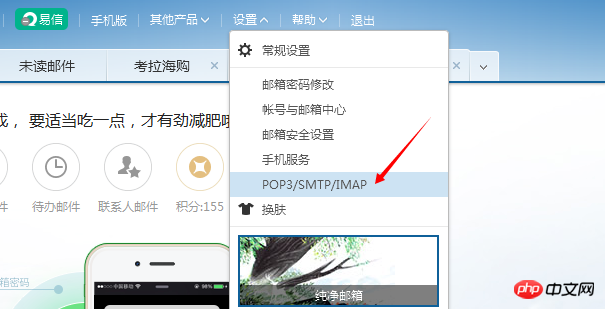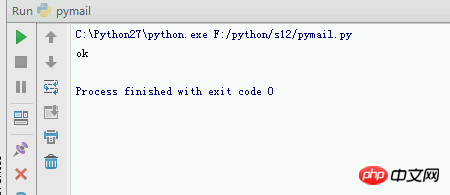 Backend Development
Backend Development
 Python Tutorial
Python Tutorial
 Share an example of how to implement SMTP to send emails using Python
Share an example of how to implement SMTP to send emails using Python
Share an example of how to implement SMTP to send emails using Python
This article mainly introduces a detailed tutorial on how to implement SMTP email sending in Python, with the SMTP email sending code attached. Interested friends can refer to it
Introduction
Python tutorial for sending emails. When I searched the website, I found a lot of them, but they all talked about a lot of principles and then launched the implementation code. When I tested using the given code to send emails, it was unsuccessful. It took me a long time to find the reason. This was all caused by the lack of detailed environment debugging, so today I will provide a detailed tutorial, step by step from environment debugging to code implementation. I hope it will help people who are still struggling to find solutions. I haven't been able to get any help from someone who can effectively resolve it.
SMTP protocol
First understand SMTP (Simple Mail Transfer Protocol). The mail transfer agent uses the SMTP protocol to send emails to the recipient's mail server. The SMTP protocol can only be used to send emails, not receive emails, and most email sending servers use the SMTP protocol. The default TCP port number for the SMTP protocol is 25.
Environment debugging
As mentioned above, the email is sent using the SMTP protocol, so you need to check whether the SMTP protocol is turned on in your sender's mailbox first. If not, it is necessary. Turn it on. I tested using the 163.com mailbox as the sender's mailbox. Turn on the SMTP protocol as shown in the figure below.
1. First log in to the 163.com mailbox (NetEase mailbox), as shown below

2. When you see an option "Settings" in the function bar above the mailbox, click the option and then select # from the drop-down menu ##"POP3/SMTP/IMAP"
 ##3. As shown in the figure below, the two red boxes above It must be checked. If it is not checked, you can check it if you want to choose to enable it. Then you can see
##3. As shown in the figure below, the two red boxes above It must be checked. If it is not checked, you can check it if you want to choose to enable it. Then you can see
in the red box below: SMTP server :smtp.163.com

After the above settings, the environment will be debugged Okay, the code can be implemented below. It is recommended to use pycharm4.5.3
editor to write the code. The following code can be used in both python2.7 and python3.4 version tests. #coding:utf-8 #强制使用utf-8编码格式
import smtplib #加载smtplib模块
from email.mime.text import MIMEText
from email.utils import formataddr
my_sender='发件人邮箱账号' #发件人邮箱账号,为了后面易于维护,所以写成了变量
my_user='收件人邮箱账号' #收件人邮箱账号,为了后面易于维护,所以写成了变量
def mail():
ret=True
try:
msg=MIMEText('填写邮件内容','plain','utf-8')
msg['From']=formataddr(["发件人邮箱昵称",my_sender]) #括号里的对应发件人邮箱昵称、发件人邮箱账号
msg['To']=formataddr(["收件人邮箱昵称",my_user]) #括号里的对应收件人邮箱昵称、收件人邮箱账号
msg['Subject']="主题" #邮件的主题,也可以说是标题
server=smtplib.SMTP("smtp.xxx.com",25) #发件人邮箱中的SMTP服务器,端口是25
server.login(my_sender,"发件人邮箱密码") #括号中对应的是发件人邮箱账号、邮箱密码
server.sendmail(my_sender,[my_user,],msg.as_string()) #括号中对应的是发件人邮箱账号、收件人邮箱账号、发送邮件
server.quit() #这句是关闭连接的意思
except Exception: #如果try中的语句没有执行,则会执行下面的ret=False
ret=False
return ret
ret=mail()
if ret:
print("ok") #如果发送成功则会返回ok,稍等20秒左右就可以收到邮件
else:
print("filed") #如果发送失败则会返回filed

Although the code can be used, some people inevitably like to mess around and break the code while playing, so here are a few knowledge points to clear up your doubts.
1. I see that there is no "#coding:utf-8" in the first line of the code above. I believe that many people who read this code do not pay much attention to this line. Anyway, it has nothing to do with the code implementation. Just select the utf-8 format when saving; let me tell you, this line of code is very important in python. It is best to add mandatory character encoding to every page, because the python2 version recognizes ASCII encoding by default, so when Chinese characters It is not recognized when it appears in python, and the error message that appears is as shown below:

Error messageExample: File"F:/python/s12/pymail.py",line2SyntaxError:Non-ASCIIcharacter'\xe5'infileF:/python/s12/pymail.pyonline2,butnoencoding
declared ;seehttp://www.python.org/peps/pep-0263.htmlfordetailsSo when the above encoding error message appears, you can add Up
#coding:utf-8#Force encoding to utf-8 or
#coding:GBK# The forced encoding is GBK[Related recommendations]
1.
4. Python uses SMTP to send emails
The above is the detailed content of Share an example of how to implement SMTP to send emails using Python. For more information, please follow other related articles on the PHP Chinese website!

Hot AI Tools

Undresser.AI Undress
AI-powered app for creating realistic nude photos

AI Clothes Remover
Online AI tool for removing clothes from photos.

Undress AI Tool
Undress images for free

Clothoff.io
AI clothes remover

Video Face Swap
Swap faces in any video effortlessly with our completely free AI face swap tool!

Hot Article

Hot Tools

Notepad++7.3.1
Easy-to-use and free code editor

SublimeText3 Chinese version
Chinese version, very easy to use

Zend Studio 13.0.1
Powerful PHP integrated development environment

Dreamweaver CS6
Visual web development tools

SublimeText3 Mac version
God-level code editing software (SublimeText3)

Hot Topics
 PHP and Python: Different Paradigms Explained
Apr 18, 2025 am 12:26 AM
PHP and Python: Different Paradigms Explained
Apr 18, 2025 am 12:26 AM
PHP is mainly procedural programming, but also supports object-oriented programming (OOP); Python supports a variety of paradigms, including OOP, functional and procedural programming. PHP is suitable for web development, and Python is suitable for a variety of applications such as data analysis and machine learning.
 Choosing Between PHP and Python: A Guide
Apr 18, 2025 am 12:24 AM
Choosing Between PHP and Python: A Guide
Apr 18, 2025 am 12:24 AM
PHP is suitable for web development and rapid prototyping, and Python is suitable for data science and machine learning. 1.PHP is used for dynamic web development, with simple syntax and suitable for rapid development. 2. Python has concise syntax, is suitable for multiple fields, and has a strong library ecosystem.
 Python vs. JavaScript: The Learning Curve and Ease of Use
Apr 16, 2025 am 12:12 AM
Python vs. JavaScript: The Learning Curve and Ease of Use
Apr 16, 2025 am 12:12 AM
Python is more suitable for beginners, with a smooth learning curve and concise syntax; JavaScript is suitable for front-end development, with a steep learning curve and flexible syntax. 1. Python syntax is intuitive and suitable for data science and back-end development. 2. JavaScript is flexible and widely used in front-end and server-side programming.
 PHP and Python: A Deep Dive into Their History
Apr 18, 2025 am 12:25 AM
PHP and Python: A Deep Dive into Their History
Apr 18, 2025 am 12:25 AM
PHP originated in 1994 and was developed by RasmusLerdorf. It was originally used to track website visitors and gradually evolved into a server-side scripting language and was widely used in web development. Python was developed by Guidovan Rossum in the late 1980s and was first released in 1991. It emphasizes code readability and simplicity, and is suitable for scientific computing, data analysis and other fields.
 Can vs code run in Windows 8
Apr 15, 2025 pm 07:24 PM
Can vs code run in Windows 8
Apr 15, 2025 pm 07:24 PM
VS Code can run on Windows 8, but the experience may not be great. First make sure the system has been updated to the latest patch, then download the VS Code installation package that matches the system architecture and install it as prompted. After installation, be aware that some extensions may be incompatible with Windows 8 and need to look for alternative extensions or use newer Windows systems in a virtual machine. Install the necessary extensions to check whether they work properly. Although VS Code is feasible on Windows 8, it is recommended to upgrade to a newer Windows system for a better development experience and security.
 Can visual studio code be used in python
Apr 15, 2025 pm 08:18 PM
Can visual studio code be used in python
Apr 15, 2025 pm 08:18 PM
VS Code can be used to write Python and provides many features that make it an ideal tool for developing Python applications. It allows users to: install Python extensions to get functions such as code completion, syntax highlighting, and debugging. Use the debugger to track code step by step, find and fix errors. Integrate Git for version control. Use code formatting tools to maintain code consistency. Use the Linting tool to spot potential problems ahead of time.
 How to run programs in terminal vscode
Apr 15, 2025 pm 06:42 PM
How to run programs in terminal vscode
Apr 15, 2025 pm 06:42 PM
In VS Code, you can run the program in the terminal through the following steps: Prepare the code and open the integrated terminal to ensure that the code directory is consistent with the terminal working directory. Select the run command according to the programming language (such as Python's python your_file_name.py) to check whether it runs successfully and resolve errors. Use the debugger to improve debugging efficiency.
 Is the vscode extension malicious?
Apr 15, 2025 pm 07:57 PM
Is the vscode extension malicious?
Apr 15, 2025 pm 07:57 PM
VS Code extensions pose malicious risks, such as hiding malicious code, exploiting vulnerabilities, and masturbating as legitimate extensions. Methods to identify malicious extensions include: checking publishers, reading comments, checking code, and installing with caution. Security measures also include: security awareness, good habits, regular updates and antivirus software.





